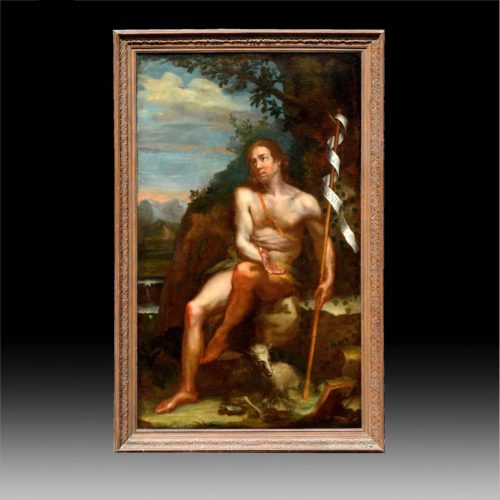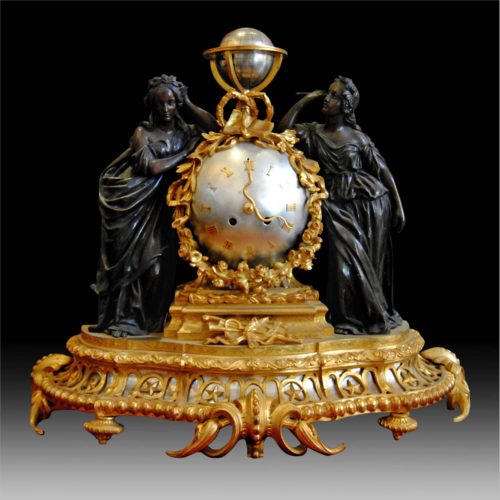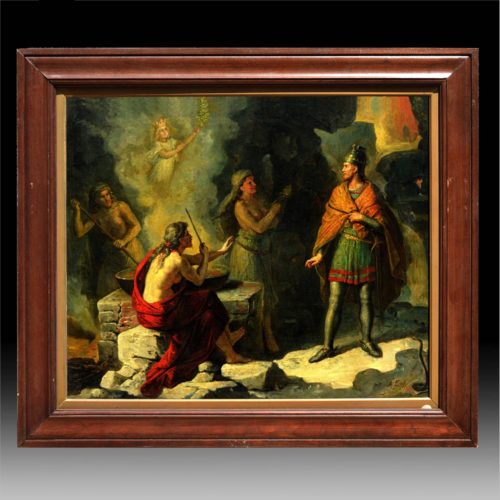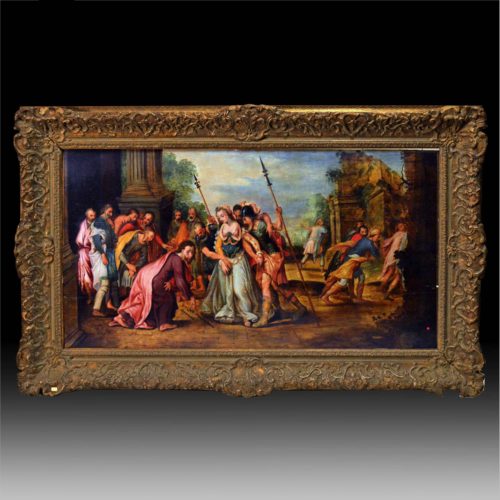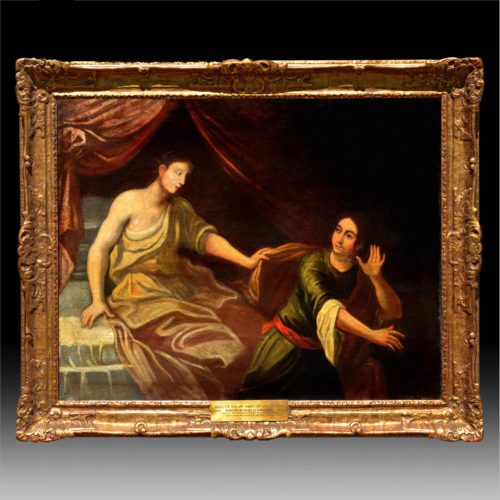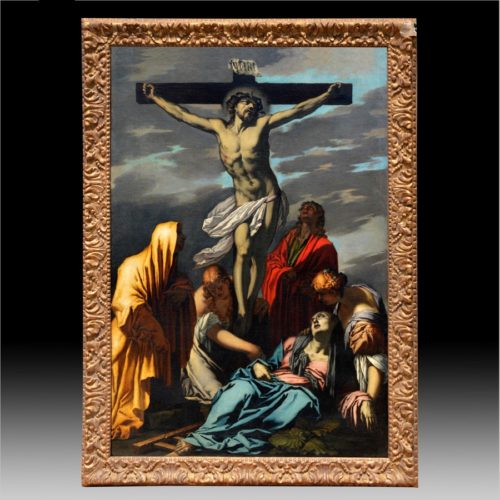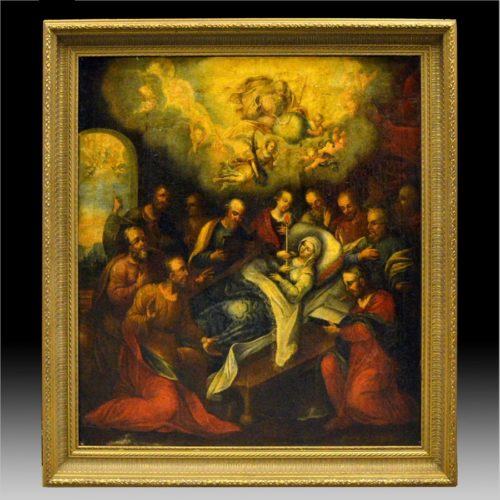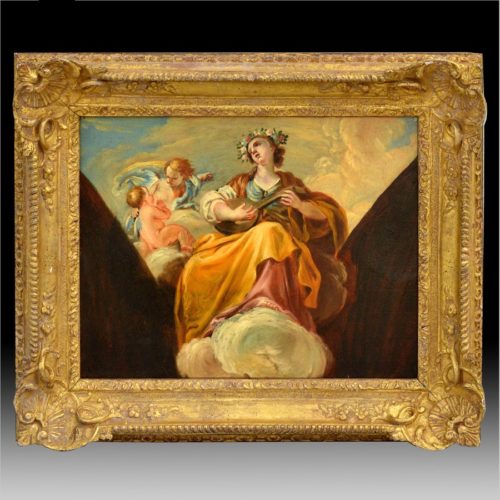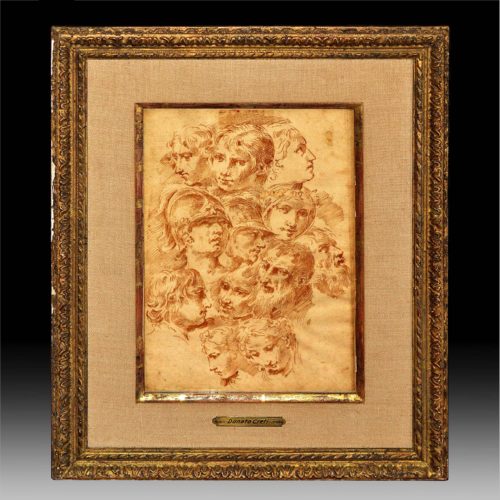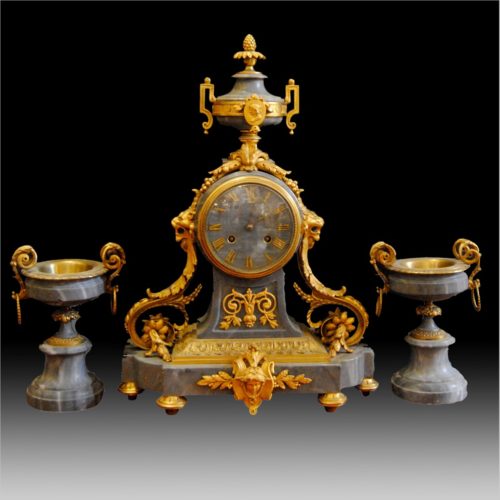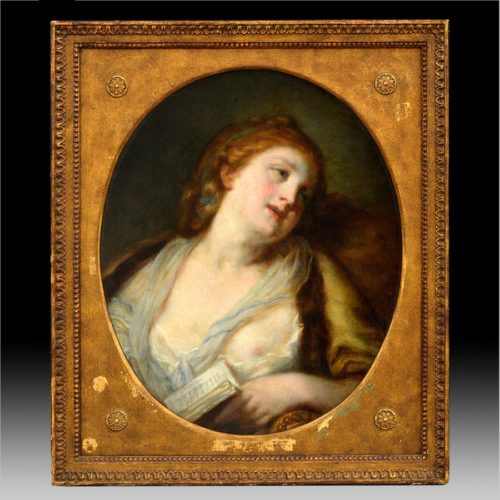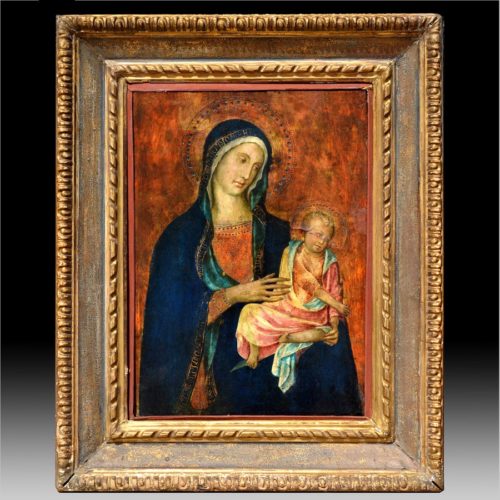View cart ““Clock with Twelve-Piece Roman numerals on dial, flanked by two Columns”” has been added to your cart.
-
Saint John the Baptist in the Wilderness
Oil on Canvas
-
A Patinated Bronze Mantel Clock with Silver Spheroid Dial (Set of 3 Pieces).
-
War Scene
Oil on canvas
22 ½” x 27”
Year of work: 1880
-
Pieter Aertson
(Dutch, 1507-1575)
Virgin Mary
Oil on panel
22 ½” x 41 ½”
Inscribed lower left
Pieter Aertsen (Amsterdam, 1508 – 3 June 1575), called Lange Pier ("Tall Pete") because of his height, was a Dutch painter in the style of Northern Mannerism. He is credited with the invention of the monumental genre scene, which combines still life and genre painting and often also includes a biblical scene in the background. He was active in his native city Amsterdam but also worked for a long period in Antwerp, then the centre of artistic life in the Netherlands. His genre scenes were influential on later Flemish Baroque painting, Dutch still life painting and also in Italy. His peasant scenes preceded by a few years the much better-known paintings produced in Antwerp by Pieter Bruegel the Elder.
-
Francesco Di Simone da Santa Croce (1480-1548)
“Joseph’s Escape from Potiphar’s Wife”
From the collection of Pinero Migliorati Lugano, Taken from Old Church in Northern Italy (one of five).
@NB-1040 #88
-
Francesco Ruschi
“The Crucifixion”
Oil on canvas
60 ¼ x 40 ½ inches
-
Abraham Bloemaert (Spanish, 1566-1651)
“Death of the Virgin”
Oil on canvas
48 ½ x 44 ¾ inches
Abraham Bloemaert (1566 – 27 January 1651) was a Dutch painter and printmaker in etching and engraving. He was one of the "Haarlem Mannerists" from about 1585, but in the new century altered his style to fit new Baroque trends. He mostly painted history subjects and some landscapes. He was an important teacher, who trained most of the Utrecht Caravaggisti, at least for a period.
-
Francisco Bayeu Y Subias (1734-1795)
“An Allegorical Figure of Music, a Study for a Pedentive”
Oil on paper laid down on canvas
13 ¼ x 16 ½ inches
Francisco Bayeu y Subias (9 March 1734 – 4 August 1795) was a Spanish painter, active in a Neoclassic style, whose main subjects were religious and historical themes. Born in Zaragoza, Aragon, he received a broad childhood education. He then moved to Madrid, winning a scholarship with the painting of the ‘’Tyranny of Gerion’’ to study in the Academia Real de Bellas Artes de San Fernando. The death of his parents and the care of his brothers forced him to return to Zaragoza, until he was recalled by Anton Raphael Mengs to help decorate the Royal Palace of Madrid.
He served as court painter to King Charles III of Spain. He was named a professor of the Royal Academy of Fine Arts of San Fernando in 1765 and director in 1788. He painted in the Charterhouse of Aula Dei in Zaragoza. In 1767 he was named court painter for Charles III, king of Spain. He was involved in the decoration of various Royal palaces near Madrid. He helped provide designs for tapestries. He also painted for the College of San Ildefonso, the Royal Monastery of the Incarnation (Madrid), the Basilica of our Lady del Pilar in Zaragoza, and the cloister of the Cathedral of Toledo.
-
Donato Creti
“Studies of Heads”
Pen and brown ink on paper
10 ¾ x 7 ¼ inches
@NB-1040 #26
Donato Creti (24 February 1671 – 31 January 1749) was an Italian painter of the Rococo period, active mostly in Bologna.
Born in Cremona, he moved to Bologna, where he was a pupil of Lorenzo Pasinelli. He is described by Wittkower as the "Bolognese Marco Benefial", in that his style was less decorative and edged into a more formal neoclassical style. It is an academicized grand style, that crystallizes into a manneristic neoclassicism, with crisp and frigid modeling of the figures. Among his followers were Aureliano Milani, Francesco Monti, and Ercole Graziani the Younger. Two other pupils were Domenico Maria Fratta and Giuseppe Peroni.
-
A Louis XVI Style Bronze and Gray Marble Garniture (Set of 5 Pieces): Clock, Pair of Tazzas, and a Pair of Five-Light Candelabra.
Height of Candelabra:
23 ½ inches.
-
Jean Baptiste Greuze (French, 1725-1805)
Oil on canvas
21 x 17 ½ inches
S71791-147
1102508-3
@AL 7/13
-
Duccio di Buoninsegna (Italian, 1255-1318)
“The Madonna and Child”
Oil on panel
18 ½ x 13 inches
Duccio di Buoninsegna (Italian; c. 1255–1260 – c. 1318–1319) was an Italian painter active in Siena, Tuscany in the late 13th and early 14th centuries.
He is considered to be the father of Sienese painting and, along with a few others, the founder of Western art. He was hired throughout his life to complete many important works in government and religious buildings around Italy. Duccio is credited with creating the painting styles of Trecento and the Sienese school, and also contributed significantly to the Sienese Gothic style.
Although much is still unconfirmed about Duccio and his life, there is more documentation of him and his life than of other Italian painters of his time. It is known that he was born and died in the city of Siena, and was also mostly active in the surrounding region of Tuscany. Other details of his early life and family are as uncertain, as much else in his history. Nevertheless, his artistic talents were enough to overshadow his lack of organization as a citizen, and he became famous in his own lifetime. In the 14th century Duccio became one of the most favored and radical painters in Siena.
CL102794-10
561202-2
@NB-1040
#7

